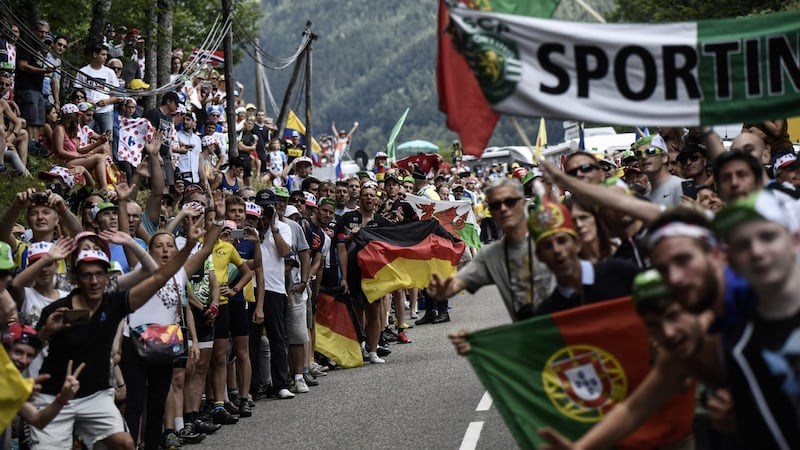We were 50km into the 13th stage of the Tour de France when we saw the first mankini.
Bearded, buxom and bulging inappropriately, its wearer was squatting in the middle of the road flexing his flaccid arms in front of us as we drove at speed just ahead of the hurtling peloton.
Wearing a garment made popular by Borat, a Kazakh, he could well have been paying homage to Fabio Aru, the Italian climber riding for the Kazakh team Astana who had pinched the yellow jersey from Chris Froome the previous day.
Or he could have just been a lumpy drunk making a show of himself. Either way, it was a sight that was utterly revolting and a blot on the beautiful Pyrenean landscape the race was winding through. The things you see when you don’t have your gun, eh?
Still, it would take more than this pathetic sample of humanity to spoil my day. For I was among a lucky herd of hacks and other luminaries being treated to a VIP experience on the Tour by Skoda, one of the race’s main sponsors.
Not only was it July 14th, Bastille Day, but the stage was one of the most enticing of the whole three-week tour. Although a mere 100km long, it featured three savage climbs, including one 10km beast of a thing which was topped off by the Mur de Peguere, a 3km ramp with an average gradient of 12 per cent that was so narrow that spectators were banned from it for the safety of the riders.
Magnificent
Attacking racing was promised. And it was delivered in spades, with French sensation Warren Barguil, resplendent in the polka dot jersey worn by the Tour’s leading climber, attacking from the gun and eventually winning the stage under the shadow of a magnificent castle in the picturesque town of Foix.
Just behind the select lead group, Ireland's Dan Martin – despite suffering from chronic back pain caused by a crash a few days earlier that saw Richie Porte, a fellow challenger for the overall victory, hospitalised with a broken pelvis – chased like a demon, distancing Aru and Froome to finish sixth on the day.

Before the stage, I went on a short group bike ride with Stephen Roche, who won the holy trinity of the Tour de France, Giro d'Italia and World Championships in 1987, a phenomenal feat – equalled only by the Belgian cycling colossus Eddy Merckx – that is unlikely to be repeated. If only we Irish properly appreciated what he and Seán Kelly achieved during their careers, they would never have to open their wallets again.
Roche, smiling and relaxed, is devoid of bitterness and remains full of love for the sport that brought him so much glory. He is also adored by the French fans, who stopped him every two steps as we wandered through the pits.
Which brings me to one of the magical things about cycling, namely the access the public has to their heroes. Not only do the pros ply their trade on the open road, where everyone and anyone can watch them suffer for free, but one can get within touching distance of them and their bikes in the pits.
As a complete bike nerd, I was in heaven among the team buses, unashamedly ogling equipment and geeking out over gear ratios and tyre pressures with fellow techie gimps. My drool is probably still stuck to some of the bikes.
Fittest humans alive
Such access is unthinkable in any other sport. Tour de France cyclists are among the fittest humans alive, competing in the toughest event in the world, and fans can just wander up to them at the start of a race and pat them on the back, not to mention push them up a hill when they’re struggling on a mountain out on the course. Can you imagine caressing an F1 car’s paintwork before a race or roughly shaking Ronaldo’s hand seconds before he takes a penalty?
For the length of the stage, we were driven with great skill – in a Skoda, naturally – at the head of the race by a Dutch former pro, stopping only for a brief but exhilarating helicopter ride to observe the peloton from above as it wound its way through hairpins up a jagged Pyrenean peak. Spectacular doesn’t quite convey the majesty of it.
Being the French national day, the fans were out in their tens of thousands, lining the route, drinking, eating, yelling and doing Mexican waves as we passed.
And if the atmosphere was electric during the race, it was nuclear at the finish, fuelled by Barguil taking the first French victory on a Bastille Day in a decade.
For the French it was a perfect end to a perfect day on one of the most competitive and exciting Tours in years. For me, only seeing Martin or his cousin Nico Roche, son of Stephen, win the stage could have topped it. But with a few days in the mountains left before the race reaches Paris, there’s still time for that yet.
Kilian Doyle was a guest of Skoda Ireland at the Tour. Welovecycling.com












